Dialling in the perfect metal tone with your amp settings can be a bit tricky sometimes. But in this article, I’ll go through each basic setting and where to start, along with the adjustments to make if it doesn’t sound quite right. Then at the end, I’ll go through some starting amp settings for some of the most popular metal songs!
The Quick Answer
To achieve a good metal tone, have your amp settings on high for bass and gain, mid-low for the mids setting and mid-high for the treble setting.
- Gain: 8-10
- Bass: 7-9
- Mids: 3-5
- Treble: 5-7
The key to achieving a good metal tone is high gain, high sustain and lot’s of low-end (bass).
Remember, this is just a starting point. Now we will go through each basic control and how to tweak it, some common issues you may run into and finally some starting points for the amp settings of popular metal songs.
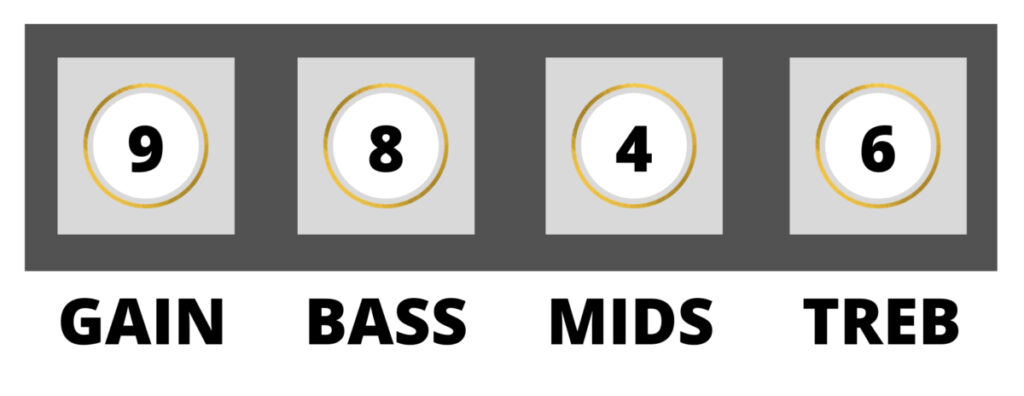
The Basics
Let’s start with the four main controls you need to consider:
- Gain
- Bass
- Mids
- Treble
- EQ
Get these spot on, and you’ll be well on your way to achieving that characteristic metal tone. On some amps, you may have separate bass, mids and treble controls, but on others, this may be combined into a single EQ control. Here’s how to set all of them.
Gain
The gain setting may alternatively be called the drive or distortion setting on some amps, but the same principles apply here.
For most metal songs, the gain will be between 8-10 to give you enough distortion for punchy riffs and solos. If you have a solid-state amplifier, simply turn the gain up to almost maximum. If you have a valve (tube) amplifier, things get a bit more complicated.
To achieve the classic metal tone with a valve (tube) amp, you will need to turn the volume high enough so that the tone begins to break up and distort. Of course, this can be a problem if you are using an amp with a lot of headroom which will require a very high volume to achieve distortion. In this case, you will need to consider using a distortion pedal instead.
Bass
Most metal music has a high bass setting on the guitar amplifier. This will give the tone plenty of beef and depth to it. I suggest starting with the bass setting on 8 to begin with. This will help to provide plenty of sustain and substance to the tone, and avoid it sounding brittle and thin.
Mids
Where to have the mids-setting sparks a bit of debate amongst metal heads. A lot of popular metal bands such as Metallica, have what’s called “scooped” amp settings, which means the mids are much lower compared to the treble and bass.
I suggest having the mids control on around 4 to start with when trying to achieve a metal tone. If it sounds a bit thin and weak, consider upping it a bit more.
On Marshall amps, the mids control may not be present. Instead, it will have a “contour” control, which is essentially “mids” in reverse. So for scooped settings on this type of amp, have the contour set higher.
Check out this guide to the contour control to learn how to dial in the best setting.
Treble
Treble refers to the high end frequencies emphasised by the amp, on Marshall amps, it is often called “presence”. Treble provides clarity and definition to the tone. For metal, start with the treble setting on 7 to give enough definition to your riffs, but avoid them sounding too sharp and interfering with the vocals.
EQ
If your amp has an EQ or “tone” control, instead of separate bass, mids and treble controls, have this set on 3-4. This will give emphasis to the low-end frequencies characteristic of a metal tone. If it sounds too muddy, make sure you’re using the bridge pickup, and consider increasing the EQ control slightly.
Some amp brands also have different controls you need to consider. For more information, check out my brand-specific amp settings guides:
- Fender Amp Settings
- Marshall Amp Settings
- Boss Amp Settings
- Orange Amp Settings
- Line 6 Amp Settings
- Vox Amp Settings
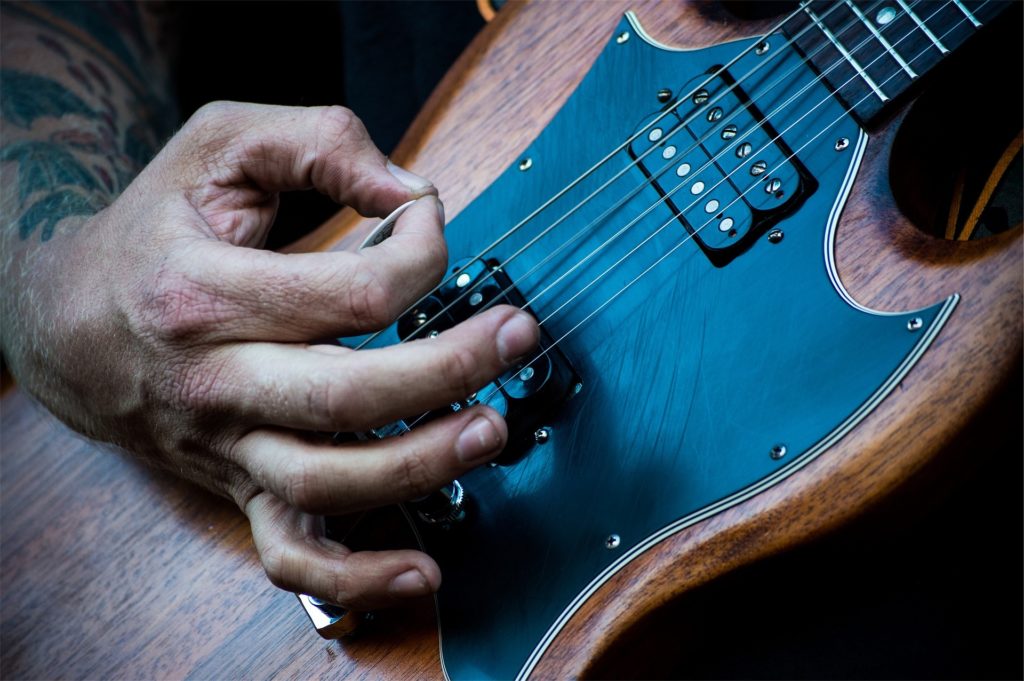
Looking for more amp setting advice? Check out my ultimate guide to amp settings to learn everything you need to know to dial in the perfect tone.
Fixing Common Problems
Of course, the exact settings you will need to use will depend on your guitar, amp and any pedal effects you’re using. So if you use the pre-set above, it might not sound perfect. Here is how to address some common issues by tweaking your settings.
Make sure you only tweak one setting at a time and listen for the difference so you can pinpoint the problem.
Muddy and Muffled Tone
This is common if you’re using passive pickups, instead of active ones. Here’s what to try:
- Decrease the gain
- Decrease the bass
- Increase the treble
Check out my guide on how to fix a muddy amp for more causes and fixes.
Feedback Issues
Increased feedback is common when you turn the gain up quite high. Here’s what to try:
- Decrease the gain
- Move the guitar and amp as far away from each other as possible
- Position the amp in front of the guitar rather than behind it
- Use a noise-gate pedal to reduce feedback
Thin, Brittle or Weak Tone
This is quite a common problem, and is particularly emphasised when palm-muting. Here’s what to try:
- Increase the bass
- Increase the mids
- Increase the gain
- Use a distortion pedal for gain instead of your amplifier
If you really want to improve your guitar playing then I recommend checking out Guitareo. You can sign up for a free 30-day trial here to get access to all the online lessons and start making real progress today
Amp Settings for Popular Metal Songs
If you’re just after some pre-sets for your favourite metal songs, try these ones out. If they don’t sound quite right, use the steps above to tweak them.
Enter Sandman by Metallica Amp Settings
- Gain: 9
- Bass: 9
- Mids: 4
- Treble: 9
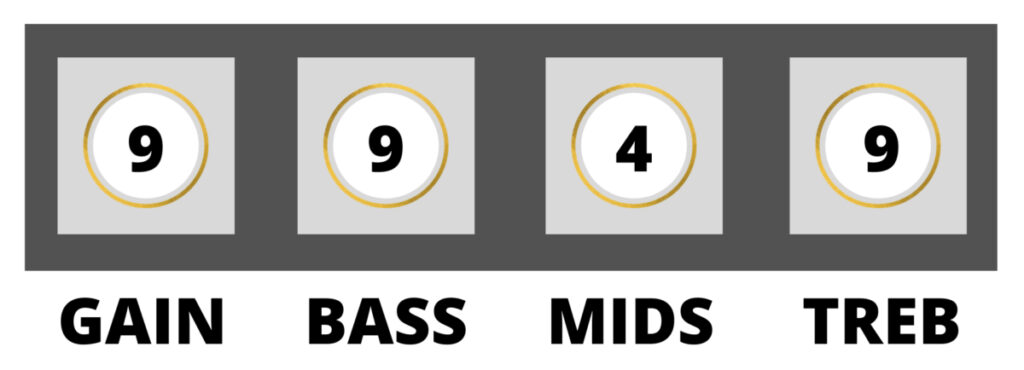
Check out my complete guide to Metallica amp settings for some more of their songs.
Run to the Hills by Iron Maiden Amp Settings
- Gain: 8
- Bass: 7
- Mids: 3
- Treble: 7
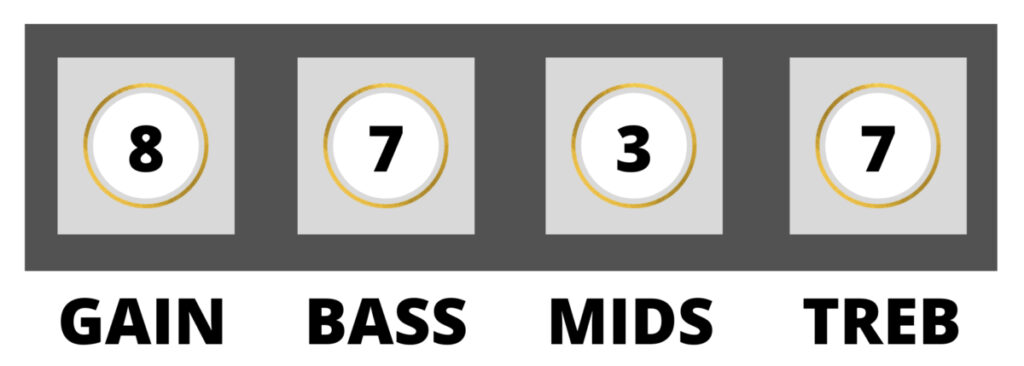
Check out my complete guide to Iron Maiden amp settings for some more of their songs.
Crazy Train by Ozzy Osbourne Amp Settings
- Gain: 8
- Bass: 9
- Mids: 3
- Treble: 4

Chop Suey by System of a Down Amp Settings
- Gain: 8
- Bass: 9
- Mids: 3
- Treble: 7
Looking for more System of a Down songs? Check out my complete System of a Down amp settings guide for more presets.
Paranoid by Black Sabbath Amp Settings
- Gain: 6
- Bass: 5
- Mids: 6
- Treble: 7
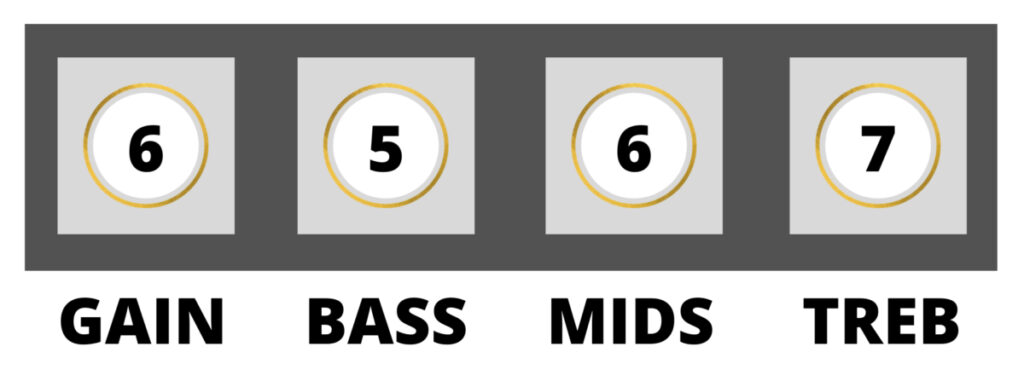
Looking for more Black Sabbath songs? Check out my complete Black Sabbath amp settings guide.
Down With the Sickness by Disturbed Amp Settings
- Gain: 10
- Bass: 9
- Mids: 3
- Treble: 4
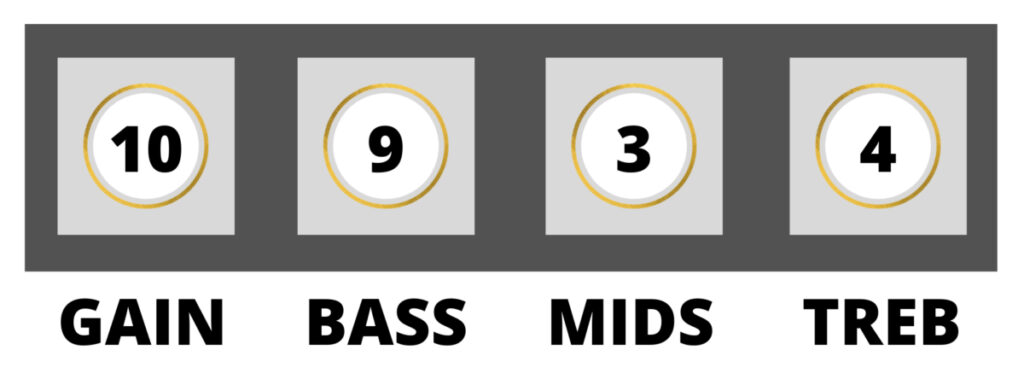
Before I Forget by Slipknot Amp Settings
- Gain: 9
- Bass: 9
- Mids: 3
- Treble: 4
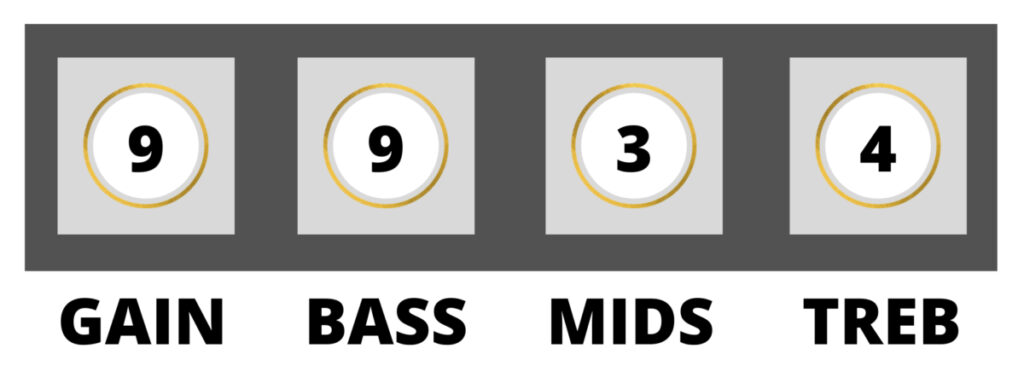
Looking for more Slipknot songs? Check out my complete Slipknot amp settings guide.
Ace of Spades by Motorhead Amp Settings
- Gain: 7
- Bass: 7
- Mids: 4
- Treble: 6
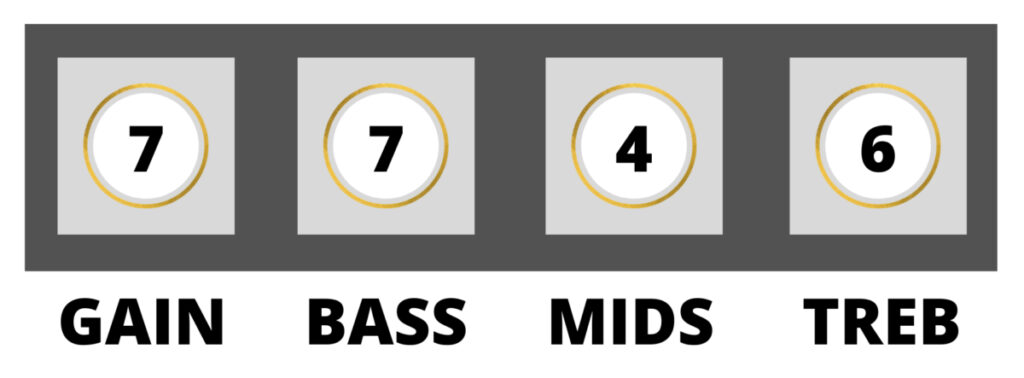
Pickup Settings
For metal, it’s best to use the bridge pickup. This will give the tone more definition and avoid it from sounding muddy, which can happen if you select the neck pickup instead. Also, make sure the tone and volume controls are set on maximum to make sure the treble frequencies played into your amplifier are strong enough.
Effects Pedals
As well as dialling in your amp settings, you might want to consider using some pedal effects. These will help the tone to have a better overall quality in a lot of cases, and give you some more control when trying to shape it. Here are some popular pedal effects for metal:
- Distortion pedal: usually produces better quality gain and sustain than an amplifier.
- Compression pedal: this “smooths-out” the tone by increasing the volume of notes picked lightly, and decreasing the volume of notes picked aggressively, giving the sound a more professional quality.
- Reverb: this helps to give the tone some presence and is particularly useful when palm-muting and soloing.
- Noise-gate: this will decrease the feedback issues present with high gain amp settings.
Quick Metal Tone Tips
Here are some of my favourite tips to get the perfect metal tone:
- Use active instead of passive pickups.
- Choose heavier gauge strings (particularly useful when in drop tuning).
- Keep the action low to make heavy riffs and quick solos easier to play.
- Lower your pickups to achieve better sustain.
Check out my article on 6 more ways to dial in the perfect metal tone.
Thanks for reading! I hope you’ve found this article helpful. Don’t forget to check out the rest of the website to learn more about dialing in the best guitar tone.
